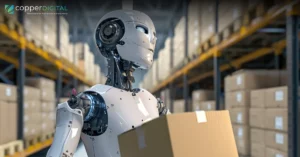In dynamic supply chain management, staying ahead means adapting to the latest innovations. From demand forecasting to navigating disruptions and enhancing transparency, the latest AI-based technologies offer robust solutions in the Australian supply chain. If you want to upgrade your supply chain with digital transformation services and take advantage of the latest technologies, do not miss this post because we are going to discuss top challenges in the Australian supply chain industry and how you can solve them with the latest tech.
5 Challenges in Supply Chain Management in Australia
Managing a supply chain business is not an easy task, and you cannot rely on traditional methods to beat the competition. You need the latest manufacturing software and supply chain software for efficiency.

Before solving such problems with the latest technologies, let us explain the top 5 challenges:
Demand Forecasting
Are you facing losses due to a lack of demand? You can use Generative AI tools to accurately predict customer demand for efficient supply chain management. However, you need to consider factors like fluctuating consumer trends, seasonal variations, and economic uncertainty to overcome this challenge. You know, inaccurate forecasts can lead to stockouts or overstocking, and you can solve them with business intelligence solutions.
Lack of Visibility
Many businesses struggle with a lack of visibility into their supply chains. This can make it difficult to track inventory levels, identify bottlenecks, and react to disruptions. Without clear visibility, businesses cannot optimize their operations or make informed decisions.
Disruptions
Supply chains are susceptible to a variety of disruptions, including natural disasters, political unrest, and labour shortages. These disruptions cause delays, shortages, and increased costs. Businesses need to be prepared for disruptions and have plans in place to minimise their impact. As a solution, you can streamline the supply chain with robots. You will learn more about it later in this blog.
Rising Costs
Thirdly, the cost of transportation, labour, and raw materials all have a significant impact on supply chain profitability. Businesses need to find ways to manage these costs while still maintaining efficient operations.
Complexity
Australian supply chains are often complex, with multiple suppliers, manufacturers, distributors, and retailers involved. Managing these complex relationships can be challenging, and it’s important to have strong communication and collaboration in place.
Read More, Navigating the Ethical Challenges of Digital Supply Chain Management
Latest Supply Chain Tech in Australia
Now, let’s look at some of the advanced technologies and use cases on how you can solve the above challenges:
Generative AI for Better Inventory Management Solutions
First, let’s talk about Generative AI, which goes beyond traditional AI. In supply chains, it can open up several exciting possibilities to solve the two most common challenges of the supply chain industry: demand forecasting and lack of visibility.
Generative AI helps you to optimise inventory management. With the help of machine learning and advanced algorithms, it predicts demand fluctuations and generates tailored production plans. Gen AI analyses real-time traffic and weather data to help your business develop risk management strategies.
Yes, Gen AI is still in its early stages, but it holds immense potential for Australian businesses, especially as an inventory management solution. By utilising the full potential of Gen AI, you can build more resilient and competitive supply chains. How can you do it? Here are some real-world use cases in Australia:
Amazon: Known for its constant innovation, Amazon is a prime candidate for using Generative AI. They could be leveraging it for tasks like:
- Predicting demand fluctuations for various products across different regions in Australia.
- Identifying potential disruptions in their vast logistics network due to weather or other factors.
- Optimising inventory levels to minimise storage costs and ensure product availability.
Walmart: Another retail giant, Walmart, is actively investing in AI and automation. Generative AI could be used for:
- Forecasting demand for seasonal items or new product launches.
- Optimising warehouse layouts and picking routes for maximum efficiency.
- Identifying opportunities for cost reduction in their complex supply chain.
Blockchain for Business Process Optimizations
Secondly, blockchain is a technology that maintains transparency in your supply chain. For a large-scale supply chain business, you should invest in creating a private blockchain. In short, you can record everything transparently here. Every step a product takes, from farm to shelf, is recorded on this tamper-proof ledger.
It boosts trust as all parties have a clear view of the journey, and consumers receive authentic information and products. Yes, it is a new technology, so many mid-size Australian supply chain companies are using private blockchain technologies for more efficiency and transparency.
The Metaverse for Interaction and Better Optimization
The Metaverse, a virtual world where users can interact and collaborate, is a potential game-changer for Australian digital transformation services. You can design or plan your warehouses and optimise your staff training, all in a safe and simulated environment. For example, suppliers and retailers could hold meetings in the Metaverse to discuss logistics and troubleshoot issues in real time.
Australian companies are well-positioned to explore this technology due to their innovative spirit and growing tech sector. While still in its early stages, the Metaverse has the potential to revolutionise how Australian businesses manage and collaborate within their supply chains.
Industrial Internet of Things (IoT) for Effective Management
The Internet of Things (IoT) is a network of physical objects embedded with sensors that collect and transmit data. This data can revolutionise Australian supply chains. Imagine sensors in shipping containers monitoring temperature and humidity for perishable goods. It ensures optimal conditions and reduces spoilage.
Imagine your smart pallets tracking inventory levels in real-time that help you eliminate stock outs and optimise warehouse space. Indeed, it is basic tracking! However, IoT has more potential, such as predictive maintenance on machinery, which can prevent costly breakdowns. With the help of IoT, AI & ML, you can take advantage of software integration services that help you rapidly grow your supply chain business.
AMR and RPA for Digital Transformation Services
Now, when it comes to robotics- you can use two models of robots for your business:
Autonomous Mobile Robots (AMR)
These intelligent machines navigate warehouses without fixed tracks. For example, you can move pallets and packages with AMRs. The best part is that AMRs adapt to changing environments, which makes them ideal for dynamic warehouses.
Robotic Process Automation (RPA)
Are you tired of repetitive tasks bogging down your Australian supply chain? You can take the help of Robotic Process Automation (RPA). These are software robots that mimic human actions and automate tasks like data entry, order processing, and invoice generation. It frees up valuable human resources for more strategic work. RPA is good for high-volume, rule-based tasks that are suitable for logistics.
For example, Australia Post, the national postal service, is at the forefront of adopting innovative technologies to streamline its supply chain. Among these advancements is Robotic Process Automation (RPA), software robots that mimic human actions to automate repetitive tasks. Here’s how Australia Post is leveraging RPA:
- They are automating repetitive tasks like address verification, change of address processing, and package tracking updates.
- Order processing for products sold in Australia Post outlets, including data entry and inventory management, can be automated using RPA.
- Mundane tasks like accounts payable processing, invoice generation, and expense reports can be handled with robotic process automation.
- RPA can automate tasks like generating manifests for mail sorting and delivery routes.
Overall, such an advanced process optimises logistics planning, reduces errors, and ensures a more efficient flow of the supply chain.
Are You Looking for Effective Business Intelligence Solutions?
Effective business intelligence solutions are essential for optimising supply chain management. Digital transformation services help you leverage data analytics and provide insights into inventory levels, demand forecasting, supplier performance, and logistics efficiency. Are you ready to make informed decisions and identify cost-saving opportunities for your business? Let’s talk with our experts about supply chain software personalised for your unique business needs.



